Bonjour! Ah, Provence – the land of rolling lavender fields, charming villages, and irresistible gastronomy. Among its many delights, one cannot overlook the boulangeries that grace every corner. Whenever someone asked me what my favourite part of my last trip to Provence was, without hesitation, my reply is always, “Our local boulangerie!”


Nothing was as perfectly Provencal as waking up at dawn every morning and walking down to the local bakery. As you approach the boulangerie, be prepared for a sensory overload. The aroma of freshly baked bread wafts through the air, drawing you in with its irresistible allure. Your eyes feast on a display of golden baguettes, flaky croissants, and other delicacies.
We came to our local boulangerie every day on our trip. And by the end of the two-week-long stay, it was like saying goodbye to new friends. They even gifted us a bottle of their homemade lavender honey. It was all wrapped up and tied with a bow. I am still thinking about how quickly we can return to Provence, almost soley to see those people again! And of course, eat their delicious baked treats!

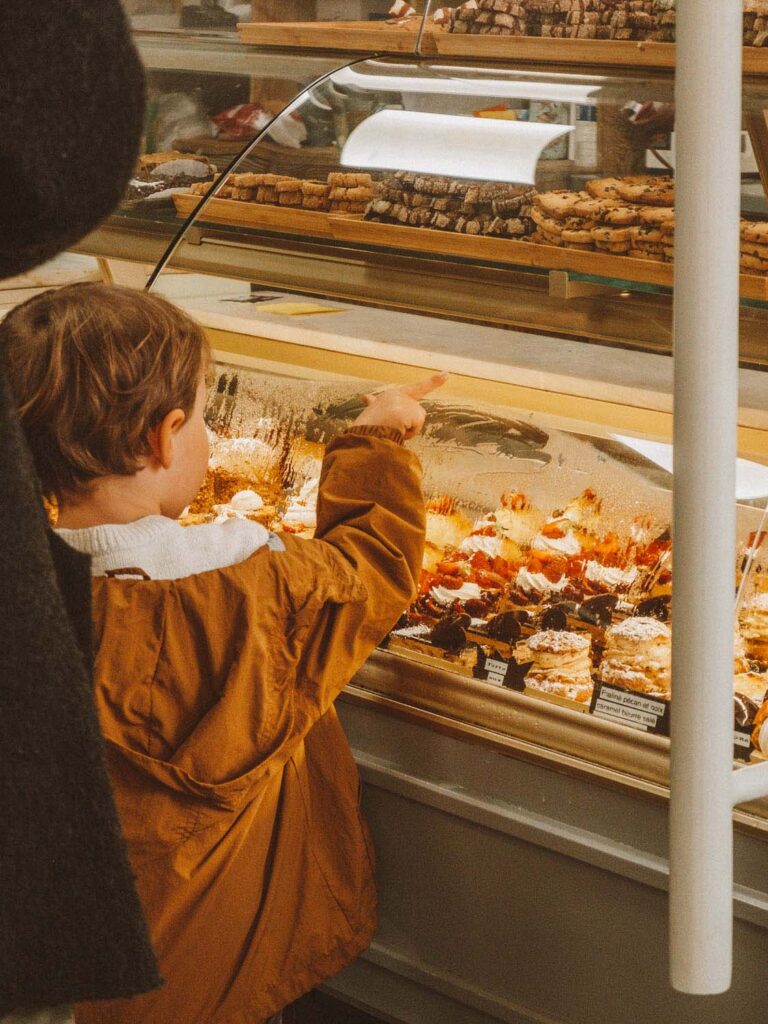
French Bread Laws
One of the greatest parts of staying in a small town in Provence is getting to visit the local boulangeries. No matter how small the town, there will be a boulangerie. And how do I know this? Well, it’s the law. In France, a law known as the “Décret Pain” (Bread Decree) regulates the production of baguettes. The law ensures that traditional French baguettes must be made with specific ingredients and cannot contain any additives or preservatives. The law also stipulates that baguettes must be sold in the same place they are made to ensure freshness. Even the smallest villages, without any storefronts, will have a large “dépôt de pain” van that will pull up every morning to sell fresh bread to the residents.

What Makes Provencal Boulangeries Unique?
Provence boasts a bountiful agricultural landscape. Looking out your window, you can see the golden wheat fields dancing in the wind across the countryside. Thanks to locally sourced flour, olive oil, herbs, and other regional produce, you’ll find that Provencal bakeries add their own unique flavour to classic French baked goods. And the laid-back atmosphere is much less intense than in big cities where boulangeries appear to be competing against each other for the “best croissant.” Provence has no competition but an environment of mutual respect, admiration and collaboration.



Be Aware of Opening Hours
Boulangeries, especially those in Provence, tend to have some interesting, shall we say, opening hours. The very best way to check the most up-to-date hours is to look at the sign outside the boulangerie. These will always list their opening hours for each day of the week (as often they will be different throughout the week.) Boulangeries typically open around 7 am as many people come here first thing in the morning to pick up food for the day or perhaps stock their restaurant pantry. Most boulangerie will close down from 12 pm till 2 or 3 pm for their European lunchtime. Often there will be certain days of the week they will close down completely, and in those cases, you’ll always find another boulangerie in town that will be open. They strive to ensure these are on opposite days so there is never a day without bread!


Boulangerie vs Pâtisseries
All throughout the French countryside, you’ll see signs for “Boulangeries” and “Pâtisseries.” But what is the difference between the two? Although they might both sell baked goods, a boulangerie comes from the French word “Boulanger,” which means “baker.” Boulangeries are required by law to bake their bread right on the premises. Whereas patisseries can include goods baked externally but sold in-store.
While Pâtisseries specialize in a wide range of sweet pastries, cakes, and desserts, don’t think you won’t find amazing sweet treats in the boulangerie. Most local bakers are just as talented at making delectable pastries as the ones you’ll find in patisseries.


Always Greet the Boulanger
Upon entering, you must greet the Boulanger or their staff. A simple “Bonjour” or “comment ça va?” (Hello / How are you) will go a long way in establishing a friendly connection. In France, not greeting someone with “bonjour” is considered VERY rude. And it will put the entire shopping experience off the wrong foot.

Choosing the Right Baguette
No visit to a boulangerie in Provence is complete without indulging in a fresh baguette. To ask for a baguette simply say, “Une baguette, s’il vous plaît” (One baguette, please). But more often than not, there will be more than one option for your fresh baguettes. Unlike in North America, where a baguette is a baguette, France has many different varieties.
Baguette Ordinaire vs Traditional
The two most common varieties are the baguette ordinaire and the baguette traditional. An ordinary baguette will always be your cheapest option and is exactly what you would expect from a baguette. A traditional or artisan baguette will be slightly darker in colour, with a thicker, crispier crust, often with pinched ends. This is always my choice as I love how the flavour is more pronounced in the crust when it is a little more well done.
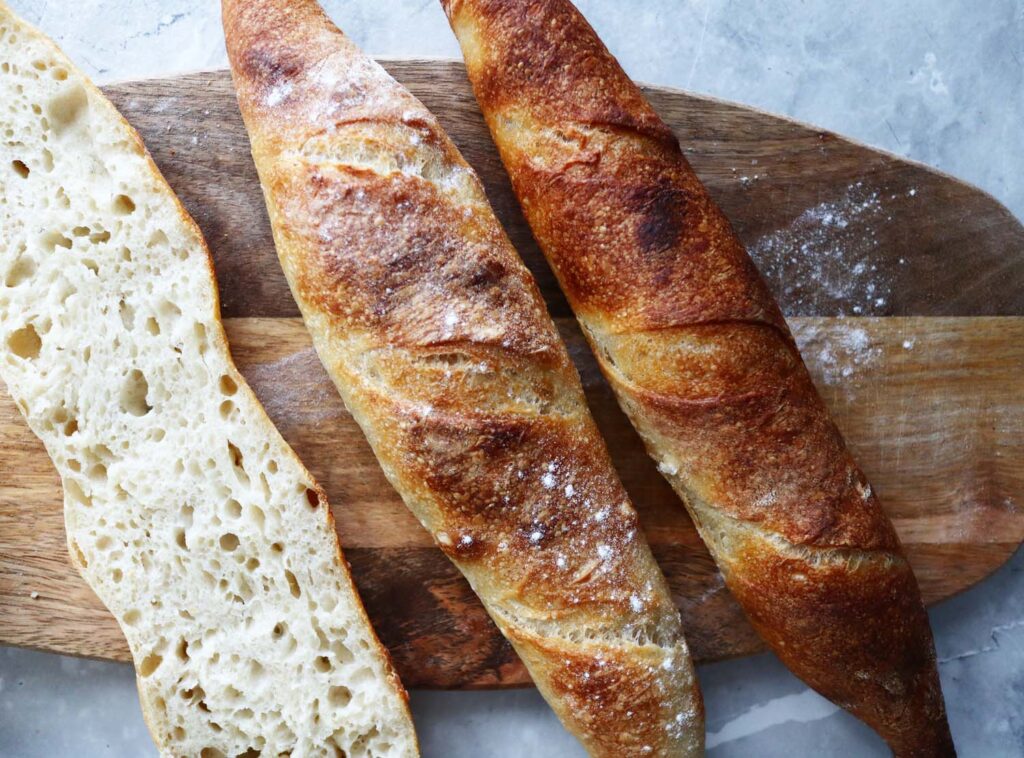
Pain d’Épi
A specialty type of baguette, often baked on weekends in Provence, is the Pain d’Épi. This type of bread is shaped like an ear of wheat, and often, they add different kinds of seeds onto the top of the bread. The different “ears” along the baguette make it easy to tear apart with your hands and share amongst the table.
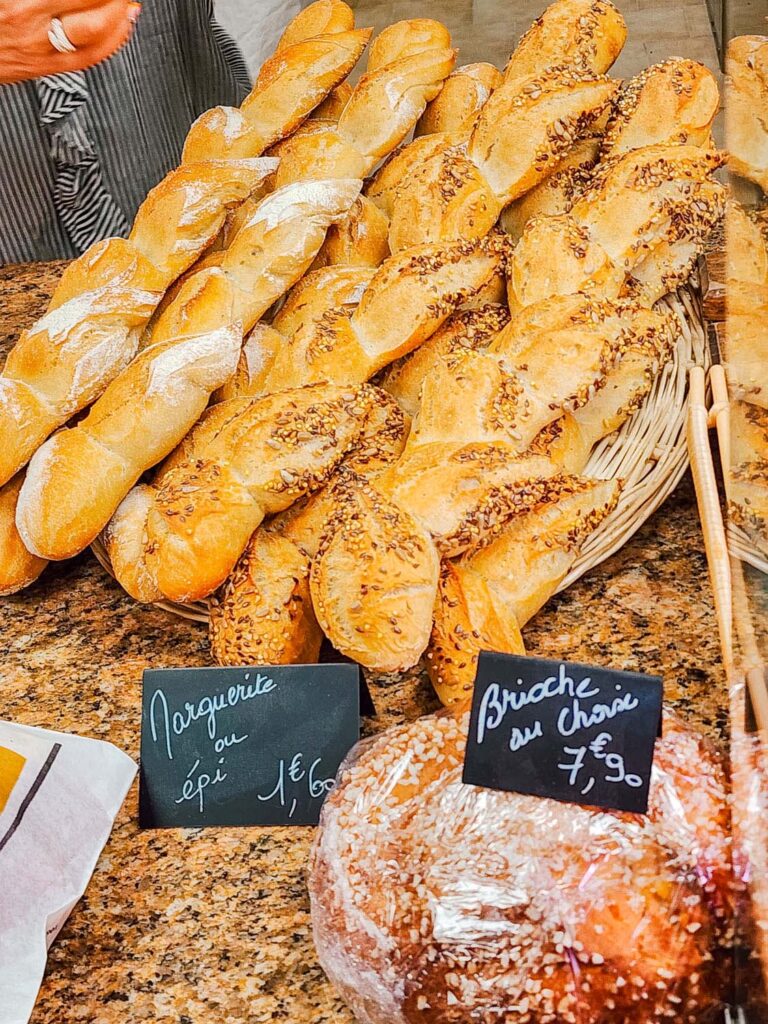
Baguette Levain
Another find is the baguette levain or sourdough baguette. As a huge fan of sourdough bread, combining the sourdough taste with the crispy baguette form was absolute perfection!
Baguette Complete
If you’re looking for something different, see if they sell a baguette complete. This kind of baguette is made with wholemeal flour and is more like multigrain bread. Sesame, poppy and flax are both baked into the bread and spread on top of the crust. A deliciously deep flavour.

French Bread
When buying a loaf of bread (or pain in French) in the boulangerie, the most popular variety is pain de campagne. Pain de Campagne, or country-style bread, is shaped into an oval with a thick crust and usually made with a blend of wheat and white flour. Other popular varies are pain au levain (sourdough), and pain aux céréales (rustic loaf with seeds and whole grains).
If you would like your bread pre-sliced, which makes it easier to serve on picnics, be sure to request for tranché (sliced.)

Provencal Fougasse
Fougasse is a traditional Provencal bread best recognized for its unique design, resembling a leaf or an ear of wheat. Bakers create decorative slashes and cuts in the dough, which open up during baking, giving the bread its characteristic shape. Fougasse highlights the use of olive oil from the region, adding a delightful flavour and aroma to the bread. Popular filling baked into the bread includes olives, cheese, sun-dried tomatoes, herbs (such as rosemary, thyme, or oregano), and occasionally bacon or ham.

Viennoiseries
Viennoiseries are a category of baked goods you find in the French boulangerie. These are sweet pastries typically enjoyed at breakfasts and are often served with coffee, hot chocolate, or tea. Although eating your pastries with breakfast is very popular, these sweets are made twice daily so you can enjoy them both in the morning and afternoon. Typical Viennoiseries include croissants, pain aux chocolate, brioche, palmiers, chausson aux pommes and more!

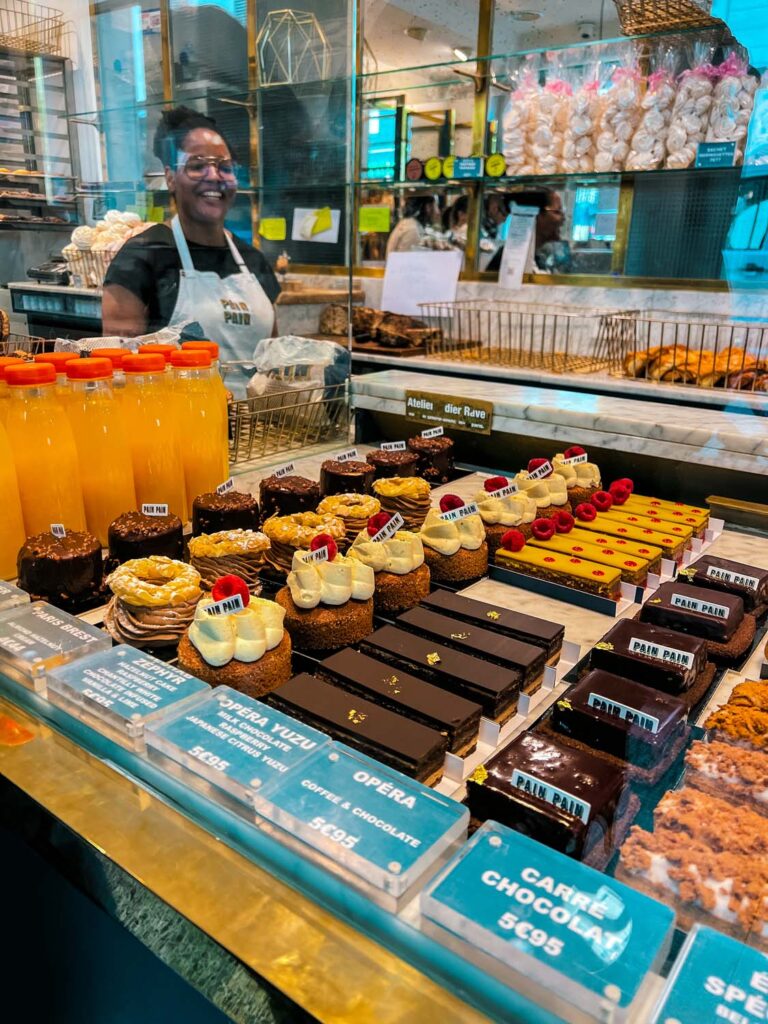
Croissants
Next on our bread-buying adventure is the irresistible croissant. As you gaze upon the golden crescents of buttery goodness, allow yourself to be transported to a world of pure indulgence. And don’t think about the butter or calories… Just close your eyes and enjoy. While you can always opt for the traditional butter croissant, my favourites are the pain au chocolate or chocolate croissants. The same croissant base is used to fold in sticks of rich chocolate which melts in the centre of the pastry.

Pain Aux Raisins
Pain aux Raisins are made with the same croissant dough but are mixed with raisins and sometimes a pistachio filling. The raw dough is then rolled into a flat, round shape. It is meant to mirror the image of a snail shell, and as such, it is often called an “escargot.“ Strange and perhaps unappetizing name for a sweet pastry, but don’t let that put you off; these are absolutely delicious.

Palmier
A Palmier, also known as “Palm Leaf” or “Elephant Ear,” is made from a thin, flaky puff pastry. When baked, the dough is sprinkled with sugar, which caramelizes to create a crisp, golden-brown exterior. The name “Palmier” (meaning “palm tree” in French) comes from its resemblance to a palm leaf.
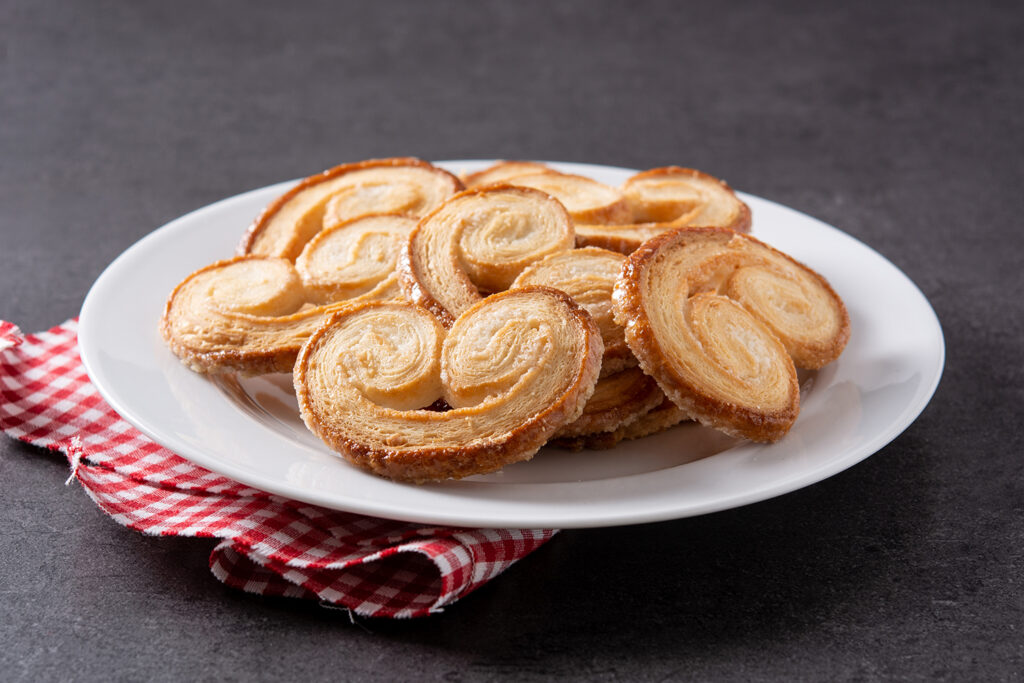
Sacristain
If you’re looking for something a little different, go for the Sacristains. Sacristains are delicate, sweet, and irresistibly crispy! These pastries are covered in caramelized sugar and almonds on the outside and have tender, flaky layers on the inside. The layers of puff pastry as twisted before baking to meld all the different flavours together. The result is a pastry that almost resembles a length of twisted rope. These pastries can be found all over France but are very popular in Provence. Because of their long shape, they are ideal to have with a cup of coffee as you dip the pastry into it repeatedly. Adding that delicious rich, and slightly bitter flavour to the sweet pastry.


Chocolate Torsades
Also similar to the Sacristain are Chocolate Torsades. The word “Torsades” comes from the French term for “twists” or “braids,” which perfectly describes the pastry’s distinctive appearance. Chocolate Torsades are made from flaky, buttery puff pastry but theses are infused with cocoa or melted chocolate. Great for kids!
Éclairs
One of the most classic French desserts has got to be Éclairs! This French pastry is known for its elongated shape, light choux pastry shell, and delectable fillings. The word “éclair” in French means “flash of lightning,” likely named due to the glistening chocolate glaze that resembles a shiny lightning bolt.
Éclairs are typically filled with flavoured creams or custards. This includes everything from vanilla or chocolate pastry cream, coffee-flavoured custard, or even fruit-flavoured creams. The pastries are then topped with glossy icing or chocolate ganache. Truly irresistible for anyone with a sweet tooth.

Tarte Tropézienne
If you love brioche, then you need to try out a Tarte Tropézienne. This amazing delicacy was born in southern France and is one of the most popular treats on the shelf. This pastry, often simply called “Tropézienne,” is made from a thick brioche bun sliced horizontally into two layers. A light, rich, cream filling is generously spread over the bottom layer. And the top is placed delicately back on top, like a sandwich. The top of the Tropézienne is then dusted with powdered sugar, giving it an elegant finish.
The pastry’s name, “Tarte Tropézienne,” was inspired by the seaside town of Saint-Tropez. Famed actress Brigitte Bardot visited Saint-Tropez during the filming of the movie, “And God Created Woman,” in the 1950s. During filming, pastry artist Alexandre Micka presented Bardot with his unique take on a brioche tart. She loved it so much that she suggested naming it “La Tarte Tropézienne.” Her endorsement helped propel the pastry to fame and contributed to its widespread popularity today.

Charlotte
A Charlotte is a classic and elegant French pastry that feels like a special treat. The dessert is iconic thanks to its ring of ladyfingers enclosing a luscious filling, usually made of fruit, custard, or mousse. It looks like a little crown filled with sweets.
Tartelettes Chiboust
Tartelettes Chiboust, also known as Tartelettes à la Chiboust or simply Chiboust Tartlets, are made from a thin pastry crust filled with wobbly custard cream. “Chiboust” refers to French pastry chef François Chiboust, credited with its creation. After the cream is added to the baked crust, it is baked again—this time with a sprinkling of sugar on top to create a caramelized crust atop the soft cream. The tartlets are usually garnished with fresh fruit, such as raspberries or strawberries. Really, whatever is in season!

Croque Monsieur & Croque Madame
If you’re looking to pick up something savoury or perhaps something to have for lunch, you should always make a point to grab either the Croque Monsieur or Croque Madame. These classic French sandwiches are made with ham, cheese, and a layer of rich béchamel sauce. A Croque Monsieur is a ham and cheese sandwich grilled or baked until the bread becomes golden and crispy. A Croque Madame is a variation of the Croque Monsieur but with the addition of a fried or poached egg on top. It’s a little messy to eat but well worth the effort! Both sandwiches come on sliced bread or on a baguette, depending on the preference of your Boulanger.


French Terms for the Boulangerie
une boulangerie: bakery
Bonjour: Hello
Qu’est-ce que vous voulez?: What would you like
S’il vous plaît: please
Je prend… : I’ll have…
Quel est le prix?: how much does it cost?
Est-ce que je peux payer avec la carte?: can I pay with a card?
Vous acceptez le sans-contact?: do you take contactless?
Un, deux, trois, quartre, cinq, six, sept, huit, neuf, dix: one, two, three, four, five, six, seven, eight, nine, ten
Thank You: Merci
Au revoir: Goodbye
Pain: bread
Pain de campagne: country bread
Pain complet: wholemeal or whole-wheat bread
pain aux noix: nut bread
pain de seigle: rye bread
pain au levain: sourdough bread
pain blanc: white bread
un pain de mie: sandwich bread
Baguette: baguette
une tranche: a slice
tranche: sliced
la pâtisserie: pastry
At the heart of every boulangerie in Provence lies a commitment to craftsmanship passed down through generations. The bakers’ dedication to preserving time-honoured techniques and using high-quality, locally sourced ingredients creates an unmistakable authenticity in every delicacy they offer. The experience of enjoying a warm croissant or a crusty baguette becomes a celebration of tradition, connecting us to the past while savouring the present. I hope you enjoyed this guide to exploring a French Boulangerie, and it helps you feel more confident in stepping inside your local boulangerie on your next trip to Provence!
Happy Travels, Adventurers



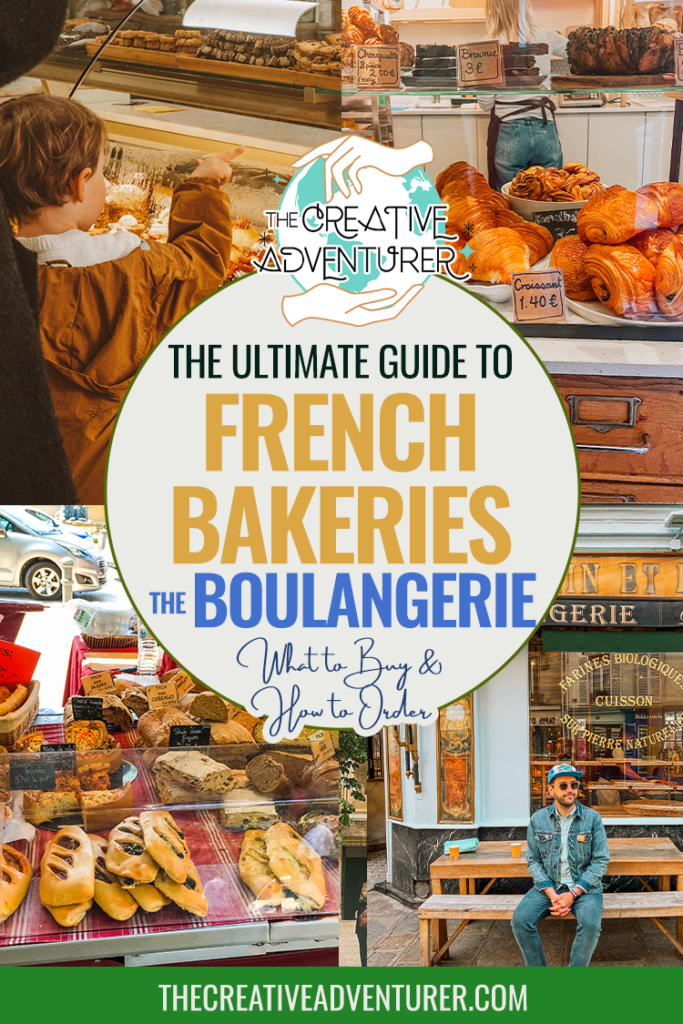








1 COMMENT
Riley
1 month agoHello.
I’m Riley from Xiama Yishan Tecnology Co.,Ltd.We saw your website
As a leading manufacturer of Plastic Bags, we supply Plastic Bags for Bread.
Xiamen Yishan Technology Co., LTD. We are located in China, specializing in the production of plastic bags.
We supply plastic bags according to customers’ needs.
I sincerely hope you can read my message and reply to me.I will wait patiently for your reply.
I hope you are well when you receive this letter.
Thank you very much!
Riley Liao
riley@xmyspackagingbag.com
Tel +86 18030316795
Xiamen Yishan Technology Co.,Ltd